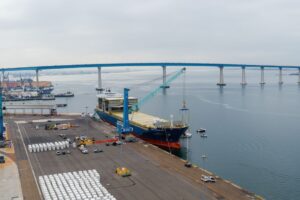With the capacity to handle the largest volume of cargo compared to any other South African port, the Port of Richards Bay is a technologically advanced port designed to efficiently manage cargo across its entire network. As a result, the port is now South Africa’s leading port serving export markets worldwide. While the port plays a vital role in the movement of cargo in and out of South Africa, one of its key functions is the export of coal from the Richards Bay Coal Terminal, which is one of the world’s leading coal terminals. With such a wealth of operations behind it, Transnet National Ports Authority (TNPA) is responsible for overseeing the port’s operations and establishing it as a hub for marine services in South Africa.
Check out the article in the magazine below:
The Port of Richards Bay, located in the north of KwaZulu-Natal province, was developed in 1976 in response to the growing industrial expansion of South Africa, which brought with it a growing need for new port facilities to handle the vast potential of the raw materials that were being mined by the country. For this reason, the coal mining industry of South Africa relies heavily on the port’s infrastructure to help it deliver its mining resources, predominantly coal, to markets across the world. As the mining industry has continued to expand, the need for more adequate rail and port facilities has arisen to accommodate large vessels that can export these goods to international markets. Therefore, over the last 49 years, the infrastructure at the Port of Richards Bay has been vastly expanded, and today it serves as a key cargo port, dealing with both bulk cargo and coal exports.
Today, the Port of Richards Bay is a deep-sea water port spanning 13 berths, with terminals handling dry bulk ores, minerals and break-bulk consignments. Divided into the three precincts of South Dunnes, Bayvue and Newark, the Port spans around 3,773 hectares (ha) and features a computer-controlled network of conveyor belts that span 40km, focused on 7 key industries. The conveyor belts are vital to the Port’s efficiency; 30 conveyor belts move materials in and out of the port 24 hours a day, which helps to keep transfer times to a minimum and promote more efficient supply chains. These conveyor belts ensure speed without compromising on the quality of service, which allows the port to maintain its vast capacity without delays.
In fact, this technologically advanced network of conveyors highlights the integration of digitalisation across the port’s infrastructure, to help deliver it as a smart, safe and secure port. By delivering the port as a smart port, where its infrastructure and capacity are supported by digitalisation, the port can promote economic growth, job creation, and prioritise sustainability for the entire port community. To achieve this, the port operates a Smart People’s Ports Programme (SPPP) which is an integrated solution designed to deliver a more streamlined and connected port where logistics, operations, infrastructure, assets, traffic and trade operations use the latest single-view digital technology.
The Port of Richards Bay is overseen by Transnet National Ports Authority (TNPA), which is the governing body responsible for managing all the commercial ports in South Africa. As part of its role, TNPA is responsible for the management, control, license oversight and compliance of all port operations. In addition to this, TNPA is responsible for the maintenance and development of the Port’s infrastructure, as well as for overseeing land leasing for all port-related activities.
One of the key terminals at the Port of Richards Bay is the Multi-Purpose Terminal, which is the result of a merger between the previous Bulk Metal and Combi Terminals. The resulting integration of these two facilities means that the terminal now handles break bulk, neo-bulk and containers across its 6-berth facility. Annually, the Multi-Purpose Terminal handles 5.6 million tonnes of cargo, which has access to 10,000 square metres (m2) of covered storage space across two warehouses, as well as an additional 8,000m2 of covered storage for sensitive cargo and 4,500m2 of shed space. In addition to this, the terminal also has 330,000m2 of open storage areas, 75,000m2 of ferro handling facility, and 55,000m2 of log terminals, which are currently leased. In addition to the Multi-Purpose Terminal, the Port of Richards Bay also has a Dry Bulk Terminal, which is one of the founding developments at the port. The Dry Bulk Terminal today handles more than 13 million tonnes of cargo, served by unique terminals that can handle multiple products across its conveyor system.
However, one of the most significant facilities at the Port of Richards Bay is the Richards Bay Coal Terminal (RBCT). As previously mentioned, coal has long been a vital industry for the port, and the coal terminal itself is one of the key reasons why the port was developed in the first place. Today, RBCT is one of the leading coal terminals in the world, delivering 91 megatons a year (Mt/a) of coal through a 24-hour-a-day operation. RBCT spans 275 ha, and a 2.2km long quay, with 6 berths and 4 ship loaders, with a stockyard capacity of 8.2 megatons (Mt). The terminal is responsible for offloading and managing stockpiles of coal, which it then loads into vessels.
RBCT is overseen by TNPA and works closely with Transnet, the largest freight logistics chain company operating across rail and ports to deliver goods across South Africa. Thus, Transnet works with RBCT to deliver the essential railway services needed to link coal mines to the port, and support the seamless shipment of coal from the coal fields to more than 900 vessels that arrive at the port every year. At present, RBCT receives coal from 65 collieries, and so the Port of Richards Bay plays a vital role in delivering coal from these to the world, and in the process, supporting the development of South Africa’s coal industry. Thus, RBCT is the leading coal terminal for South Africa, delivering both the terminal and the Port of Richards Bay as a competitive coal export avenue for South Africa’s Coal Exporting Parties (CEPs), with world-class logistics services that support the Port and RBCT’s coal operations.
In May, the Port of Richards Bay announced that it was developing a new container handling facility within the Bayvue precinct of the port. The new container handling facility is planned to increase the port’s annual capacity from 50,000 twenty-foot equivalent units (TEUs) to 200,000 TEUs, whilst diversifying the cargo handled by the port. The new container handling facility will be built with the same smart technology as has been seen across the port, including specialised equipment to ensure the timely turnaround of vessels entering the port. The development of the facility will also create over 100 new jobs for the local community. The new container handling facility agreement was signed between Grindrod Eyamakhosi Joint Venture and TNPA, with Grindrod Eyamakhosi being the preferred bidder for the 25-year concession in June last year. Therefore, the project reflects TNPA’s keen commitment to developing its infrastructure and unlocking the Port’s capacity through private-sector partnerships such as this. The container facility is expected to begin commercial operation in 2028.
Across the Port of Richards Bay, digitalisation and infrastructure development remain at the heart of its operations to ensure it can maintain its position as the largest port by volume in South Africa. With the support of TNPA, as well as various private-sector partnerships, the Port is slowly being developed to handle the growing cargo demand at the port, whilst implementing smart technologies that enable to port to diversify its cargo capacity for the future. With the development of the new container terminal at Bayvue underway, we look forward to seeing how the Port of Richards Bay will unlock greater diversity for the future, supported by its vast transport networks that help deliver cargo to and from the port every day.








